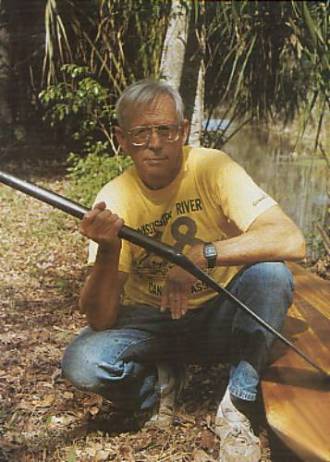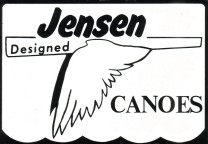A Conversation with Gene Jensen - Paddler Magazine - August 1993
I had driven up from Orlando to meet the master, and in late morning we had talked at his dining room table and then finished off a light lunch. Now it was time for a leisurely paddle to work off the meal. We select a tandem from the bank, right it and ease it into the water.
There’s something intimidating about paddling bow for a legend. Not only did my partner design and build the canoe we paddled, but he also, among other contributions to the sport, put the bend into the bent-shaft paddle. The canoe surges forward with each stroke. Most of the power comes from the stern.
At 64 Jensen has grayed; but he is still lean and trim, the result of a long career in marathon racing, both pro and amateur. It is a career that started when he was a teenager and continues today. “I’ve slowed down,” he explains, “but I’ll still race about 20 times a year. Not all of them are long races. I enter some nine- and 10-milers, particularly down here in Florida.”
As we move along the channel toward the main river, Jensen mixes “huts” easily into his conversation; so easily, in fact, that in the bow I have to concentrate on not missing them. “Hut” for those of you not involved in marathon or “hit and switch” touring, is the verbal signal tandem paddlers use to call for switching sides. And there is good reason that it comes easily to Jensen. He and then partner Tom Estes invented the term as it applies to canoeing.
“My partner and I were paddling on the river, just sort of fooling around. We were watching other canoes go by, and some of them switched and some didn’t. Some looked like they counted every five or six strokes and switched. Nobody said anything, but they switched sides. We decided the best thing to do would be to call some sort of signal so that the other guy would know (when to switch).”
“Estes had just gotten out of the service a year or so earlier; and he said, ‘Well, in the service when you’re marching a group and you call a particular movement, these drill instructors accentuate it with a sound everyone can hear. They use ‘hut’…column right, hut; left flank, hut.’ So we used ‘hut’.”
“That’s how the thing got going, and I tell you it tickled me the next time we went to Quebec. Nobody up there hollered anything in 1949; not one person up there said a word. In 1950 we got up there and it was ‘Hut, hut…hut, hut, hut!’” Jensen broke into a laugh and added, “Boy, that caught on in a hurry, but it’s really just common sense.”
If “hut” caught on quickly, so did the bent shaft paddle, a Jensen invention which dates back to 1971.
“That was one of my hairbrained schemes. I was out paddling next to two people that we paddled with fairly regularly. I started to notice the characteristics of their paddles. They had to dig these enormous holes, and their paddles would really cavitate. They didn’t seem to go as fast as they should.”
“I decided, well, maybe the best thing to do is bend that shaft back a little so that the blade comes in at the beginning of the stroke rather than further back. That’s how the whole thing got started.”
“The first one I did had about a seven-degree bend in it. I got down the river with that all right. I remember a friend looking at me and saying, ‘There’s Jensen with another gimmick.’”
“We took them up to Quebec and used them in an international competition. Serge (Corbin) saw them, and everybody saw them. We had a good canoe and really did well, but everybody saw the paddles. And they adopted those buggers right then! It wasn’t too long before a friend of mine came back from the South Seas and told me they were using them in Tahiti. They didn’t take long to go worldwide.”
Occasionally Jensen wonders what might have happened if he had tried to patent the bent shaft, but he’s philosophical and doesn’t dwell on it. “I didn’t know anything about patenting a paddle, whether I could or not. But I didn’t and that’s all there is to that.”
And what does he think of the ergo paddle, the latest twist in shaft bending?
“Well, I really haven’t taken a close look at one. But, you know, the efficiency of moving a boat through water is contingent on the paddle not breaking the surface of the water and cavitating. And a good paddle can help you make a better stroke. The kayak wing paddle does that. It forces your body to perform the task more efficiently. I think that’s really the secret. And that essentially is what the bent shaft is for. It prolongs the front part of the stroke, and that is where you have the power.”
(Jensen explains cavitating as: “a little like being on ice at a stop sign. If you hit the gas too hard, your wheels spin out. They can’t use the traction they have available to them. You can do the same thing on water. If you come into your stroke real hard at the start, if you come down ‘bang,’ real hard, it will just cavitate and go right through the water. You’ll lose that potential power.”)
“If you paddle alongside someone like Serge Corbin, or (Al) Rudquist or (Bruce) Barton, you’ll notice that they hardly make a swirl in the water. They’ll pass right by you and hardly disturb the water. They don’t churn the water up and leave big holes. All their power is going right to the canoe.”
Jensen fingers his chin for a moment, then adds, “You know, I’ve made paddles that have two or three crooks on them and were bent other ways. Some had a little hook on the front and some had spoon blades. In the long run you really have to check that all out on a stopwatch to find out if it’s doing you any good.”
But ‘hut’ and the bent shaft are just icing on the cake of Gene Jensen’s contribution to canoesport. It is boat design that has brought his name to the forefront of canoeing. He is arguably the best designer of both competition and touring open hull canoes in America today. He is, in short, the designer other designers try to keep up with.
And like the terminology and the bending of the shaft, his entry into the design arena was born of competition and the need to go faster. Jensen entered his first race in 1948, and he started big…a 500-miler from Bemidji to Minneapolis on the Mississippi.
“Ever since I was a teenager, I’d fiddled around on the river in canoes and kayaks; and I really wanted to enter this race. I’d talked to four or five people, paddled with them; and for one reason or another they’d decided they didn’t want to do it. I finally settled on a guy named Tom Estes, and we got along very well.”
“We came into the race in tremendously good shape; but we noticed as the race progressed that our 16-foot canoe was not as good as some of the others, especially in shallow water. (It was, however, good enough to win the race.) We decided we’d better design our own canoe for 1949, so I went down to the library and found out how to design a canoe out of a boat book.”
The result of that first foray into design was an 18.5-foot V-bottom craft that Jensen describes as a “nightmare.” Made of plywood, it weighed in at an estimated 85 pounds; and says Jensen, “If you put it in the water, it laid right on it’s side. We never found anyone except a couple of Canadian kids up in Quebec who could ride that thing, actually paddle it.”
Next came a round-bottom wood strip, a project that meant inventing a whole new technology. “There was no technology out there, no one to teach you. We had to do it from scratch.”
One canoe led to another and in a world where people designed canoes “because other canoes were that way,” Gene Jensen looked for the reasons that boats did what they did. Winning races provided the motivation that led to a career. To date more than 100 Jensen designs, both competition canoes and recreational, have gone into commercial production.
“We realized early on that one canoe was better than another, and nobody really knew why. Experimenting became the rule. “I’d design one with the widest point a little ahead of center and the volume ahead, then I’d try one with the volume behind center. It was trial and error.” And what worked in racing had ramifications for recreational canoes.
“As this thing has evolved, the average canoeist out there in the recreational area has refined his requirements. And we’ve had to refine designs to fit those requirements. As a result a lot of canoes have had to evolve into something a little more sophisticated. They’ve had to keep pace with the demands of the canoeist.”
“Paddlers have become more selective as to what they think is a good canoe. They’re starting to look the field over, and that crosses over nice with competition canoes. Nobody wants to take two strokes to go someplace they can get in one. No matter how slow you go in a canoe, an efficient hull is your best choice. If it fills all the rest of your needs, stability, carrying capacity and the like, then efficiency is what’s left to make the difference.”
A canoe has only so many elements with which to work. Is there a point where you’ve designed the ultimate canoe?
“I don’t think so,” says Jensen. “I do a lot of experimental work. If I get a notion that I want to try something, I’ll go ahead and do a prototype on it.
“I think the America’s Cup in sailing really epitomizes man’s inability to corner the market in the slow-moving hull displacement thing. They’ve got millions of dollars and computers to work with, and yet, down in New Zealand they got to the race and they didn’t take the hull they thought they would. Why? They said all the other guys were taking shorter ones. All the computers and that business went in the toilet. ‘The rest of them are taking shorter ones.’ You know, we’re not really too far apart.”
Computers! What’s happening in computer-aided canoe design? Jensen says a lot of people are using them, then he adds, “A computer’s a little like a snow blower. You’ve got to put ‘em on the sidewalk before they’ll do anything. You’ve got to put the right program and the right information into the computer before it will do anything.”
“Experimentation is the key. You have to keep an open mind and you have to deal with all those characteristics that affect the hulls. For me it really helps that I race on a regular basis and paddle three or four times a week. You get a good feel for what works.”
How long does it take to go from concept to wood strip prototype? “Usually about a week,” says Jensen, “but I’ve done it in 48 hours. But that’s the easy part. Once you’ve got the prototype, the real work begins, the on-water testing and the fine-tuning and corrections that are necessary on every new design.”
“And you have to avoid the trap of thinking that you know the answer. One thing you learn about this business is that you really don’t know anything. The minute you start thinking you know it, then that’s when you really get yourself into a corner. You just compound your mistakes.”
“The bottom line is that you can talk all you want to; but if those things don’t perform out there against the clock and in races, then you’re not in business.”
Outside on the lawn beside the water a new woodstrip C-1 lies bottom-up waiting for its turn against the clock. The true test of competition may still be ahead, and you get the feeling that Gene Jensen is still very much in business.
Story by Chuck Weis



